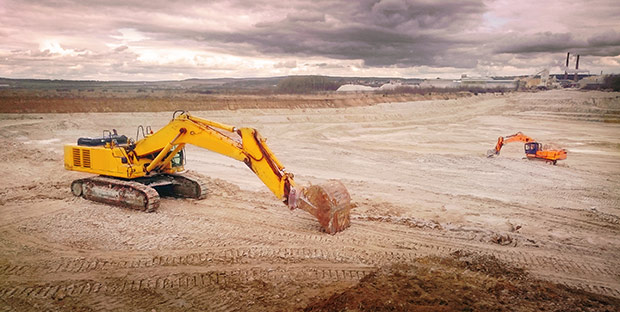BUILDING TRENDS: ESOPs gain popularity with construction firms
By: Michaela Paukner, [email protected]//January 23, 2020//
BUILDING TRENDS: ESOPs gain popularity with construction firms
By: Michaela Paukner, [email protected]//January 23, 2020//

— Tim Stewart, employee benefits attorney at DeWitt LLP Law Firm in Brookfield.
An increasing number of construction owners are putting their trust in their employees as they plan for the future of their businesses, a trend evidenced by the exploding interest seen in the past five years in employee stock ownership plans.
An ESOP gives workers an ownership interest in their employer. But that doesn’t mean the plans bring about a revolution in who’s running a company. Even after an ESOP is adopted, the same managers often stay in place and run the business under the guidance of a board of directors.
“If you have a high-engagement workforce and a profitable business, that’s going to be a great fit for an ESOP,” said Tim Stewart, employee benefits attorney at DeWitt LLP Law Firm in Brookfield.
Stewart said general interest in ESOPs has increased over the past decade. He estimated that he receives inquiries about ESOPs about once a week. Ten years ago, he’d maybe get one a quarter.
Word-of-mouth has contributed to the heightened interest, Stewart said. The plans work for businesses in industries in which competitors often have close dealings with each other — like construction and trade.
Paul Martzke, president of Green Bay-based Immel Construction, said officials at his company first heard of ESOPs at a biannual contractor roundtable. A facilitator suggested he and his colleagues look into an ESOP. They ended up liking what they found.
“It would be an exit strategy that would have a positive effect on the employees,” Martzke said. “It was also important to us that the (company) legacy remained intact, and with other types of ownership transition, the legacy of Immel Construction would probably not exist in the same way that it does today.”
Immel officials eventually decided an ESOP was the best way to go and spent about a year and a half planning for the change. The company completed the financial transaction in July 2019. The new management structure took effect in January. Martzke said he’s seen small but beneficial changes in the workplace since employees learned about the ESOP in November.
“We are seeing employees thinking about how they do their daily tasks a little bit differently,” Martzke said. “As employee owners, everybody’s efforts are starting to be felt as more directly relating to their success.”
Immel is not alone in seeing benefits.
With the 2008 recession more than a decade in the past, businesses working in new construction are now making record profits. Meanwhile, many company leaders are getting older and are thinking hard about what’s next for them and their companies. Stewart said an ESOP is often the best way to hand a company on to a new group of owners.
“Traditionally, these companies, especially in the small to mid-size range, are not targets for private equity money, and there’s very little merger activity,” Stewart said. “They’re waiting on each other to retire or move on, and then the competitors go in and try to take their clients.”
Stewart said DeWitt did 11 ESOP transactions in 2019, seven of which were related to construction. He said most of his clients come to him with some knowledge of ESOPs, and they’re quickly convinced of the plans’ benefits — especially the tax breaks.
“That’s often what I refer to as the secret sauce of an ESOP transaction,” Stewart said. “An ESOP is a tax-exempt retirement plan. If that tax-exempt entity owns all the shares of an S corporation, all the profits flow through to the tax-exempt entity, and there are no taxes.”
ESOPs are overseen by the U.S. Department of Labor because they’re qualified retirement plans. That gives the department the right to second-guess an ESOP to make sure it was done correctly and a reasonable price was paid.
“The Department of Labor has essentially decreed you can’t arrive for a fair price for the company unless you have someone on the other side advocating independently,” Stewart said.
Most companies will hire a trustee to negotiate in the best interest of an ESOP. Stewart said although it’s not illegal to complete an ESOP transaction without a trustee, it’s very risky to do so.
Once completed, an ESOP transaction is beneficial to all parties involved, Stewart said. Business owners can exit on their terms — whether they’re ready to retire in several months or several years — with their legacy intact and employees protected.
“They love the idea of having their business continue on as it has with the same name and the same people after they’re gone,” Stewart said. “We get companies that are in small towns that say ‘I feel obligation to this community.’”
Legal News
- Former law enforcement praise state’s response brief in Steven Avery case
- Eric Toney announces re-election bid for Fond du Lac County District Attorney
- Former Wisconsin Democratic Rep. Peter Barca announces new bid for Congress
- Republicans file lawsuit challenging Evers’s partial vetoes to literacy bill
- More human remains believed those of missing woman wash up on Milwaukee Co. beach
- Vice President Harris returning to Wisconsin for third visit this year
- Wisconsin joins Feds, dozens of states to hold airlines accountable for bad behavior
- Trump ahead of Biden in new Marquette poll
- Bankruptcy court approves Milwaukee Marriott Downtown ‘business as usual’ motion
- New Crime Gun Intelligence Center to launch in Chicago
- Arrest warrant proposed for Minocqua Brewing owner who filed Lawsuit against Town of Minocqua
- Wisconsin Supreme Court justices question how much power Legislature should have
WLJ People
- Power 30 Personal Injury Attorneys – Russell Nicolet
- Power 30 Personal Injury Attorneys – Benjamin Nicolet
- Power 30 Personal Injury Attorneys – Dustin T. Woehl
- Power 30 Personal Injury Attorneys – Katherine Metzger
- Power 30 Personal Injury Attorneys – Joseph Ryan
- Power 30 Personal Injury Attorneys – James M. Ryan
- Power 30 Personal Injury Attorneys – Dana Wachs
- Power 30 Personal Injury Attorneys – Mark L. Thomsen
- Power 30 Personal Injury Attorneys – Matthew Lein
- Power 30 Personal Injury Attorneys – Jeffrey A. Pitman
- Power 30 Personal Injury Attorneys – William Pemberton
- Power 30 Personal Injury Attorneys – Howard S. Sicula









